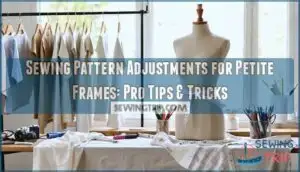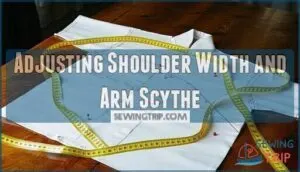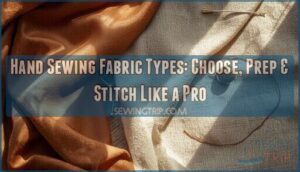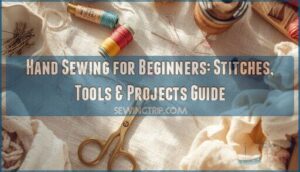This site is supported by our readers. We may earn a commission, at no cost to you, if you purchase through links.

Adjust armholes by raising them slightly and narrowing shoulder width proportionally. Don’t forget to shorten sleeves at both the upper arm and forearm sections to maintain proper proportions.
For pants, reduce the rise and shorten the inseam while adjusting the crotch curve. Think of it like tailoring a suit – every element needs to work together harmoniously.
The secret lies in understanding which measurements to scale and which to keep constant for that perfect fit. This requires a thorough understanding of how all the elements interact, much like harmoniously working together.
Table Of Contents
Key Takeaways
- You’ll need to shorten more than just hemlines – reduce bodice length between bust and waist by 1-2 inches, adjust armholes by raising them slightly, and shorten sleeves at both upper arm and forearm sections to maintain proper proportions.
- Don’t just make simple hem adjustments – calculate your personal scaling ratio by dividing your height by the pattern’s standard height (usually 5’5"), then use this percentage to guide all your pattern modifications for consistent proportional fit.
- Focus on three main adjustment zones: shoulder-to-bust distance, bust-to-waist length, and knee-to-ankle measurements, while raising waistlines that typically sit 2.5 inches too low on petite frames and adjusting armhole depth to prevent gaping.
- Create muslin mockups first to test your adjustments before cutting expensive fabric, and document each alteration in a sewing journal so you can refine your techniques and build a reference for future projects.
Petite Frame Considerations
When you’re adjusting sewing patterns for petite frames, you’ll need to understand that your body proportions are scaled down vertically from standard patterns designed for 5’5" heights.
Petite sewing isn’t just about shortening hems—it’s about rescaling your entire silhouette for perfect proportional harmony.
Your torso, arms, and legs require specific shortening in key zones like shoulder-to-bust distance and waist-to-hip length to achieve a proper fit that doesn’t overwhelm your frame.
Vertical Measurements and Proportions
Understanding your petite frame starts with recognizing that you’re not just a shorter version of standard sizing.
Your torso length, limb length, and height distribution create unique proportions that standard patterns can’t accommodate.
Petite scaling involves more than hemming – it requires strategic petite sewing adjustments across multiple body measurements.
Key vertical measurements for petite frame sewing include:
- Shoulder-to-bust distance (typically 1-2 inches shorter)
- Bust-to-waist length (requires proportional reduction)
- Waist-to-hip measurement (affects overall pattern height)
- Knee-to-ankle length (impacts trouser proportions)
- Total torso length (from shoulder to natural waist)
Key Shortening Zones and Adjustments
Where exactly should you make those key cuts when adjusting patterns for your petite frame?
Focus on three main zones: shoulder-to-bust distance, bust-to-waist length, and knee-to-ankle measurements.
These petite sewing adjustments target torso length, sleeve adjustments, and pant length modifications.
Smart bodice shortening and shoulder adjustments in these key zones maintain design proportions while ensuring your sewing pattern alteration fits perfectly, through effective pattern adjustment.
Bust and Waist Adjustments for Petites
When you’re adjusting petite sewing patterns, bust darts and waist placement often need tweaking.
Your petite body measurements require specific bust adjustments – typically shortening the shoulder-to-bust distance by half an inch.
For waist adjustment, raise the waistline and narrow the circumference slightly.
Understanding how your measurements compare to CYC sizing charts can help identify fit issues.
This torso shaping creates better proportion whether you’re working with patterns for curvy petites or slim petites through proper sewing pattern alteration.
Curvy Vs Slim Petite Body Types
Both curvy and slim petite frames need different approaches when tackling petite sewing patterns.
Your body’s unique shape determines which petite clothing patterns work best and what sewing pattern adjustments you’ll need.
Consider these key style differences for petite sewing success:
- Curvy petites face fitting challenges with bust darts and waist definition
- Slim petites struggle with proportion balancing and creating shape
- Fabric choices affect silhouette goals differently for each body type
Common Alteration Issues
When you adjust patterns for petite frames, you’ll face predictable challenges that standard-sized patterns create.
Your biggest struggles will be gaping necklines, low-sitting waistlines, and sleeves that extend past your fingertips, but these issues have straightforward solutions.
Neckline and Armhole Adjustments
When standard patterns meet petite frames, gaping necklines and loose armholes create an unflattering silhouette.
You’ll need to raise necklines and reduce armhole depth by 0.25-0.75 inches after adjusting shoulder slope.
Petite sewing patterns require precise arm scythe modifications to eliminate armhole gaping.
These neckline adjustments transform oversized openings into a polished petite fit, achieving a more flattering silhouette.
Waistline and Torso Length Adjustments
One major headache you’ll face involves waistlines sitting 2.5 inches too low on petite frames.
This creates unflattering baggy sections even after basic hem adjustments.
You need to raise the waistline placement and shorten torso length simultaneously.
Focus on blouse length problems by adjusting bodice measurements between bust point and natural waist for proper dress length solutions.
Sleeve and Pant Length Reductions
Simply shortening sleeves and pants at the hem won’t give you the proportional fit you’re after.
Smart sleeve modifications involve removing length above the elbow to maintain proper cuff proportions.
For petite pant alterations, adjust both the inseam and rise simultaneously.
This shortening method preserves the garment’s intended silhouette while ensuring sleeve tapering and proportional hemming look professionally finished.
Garment Volume Reduction Techniques
Beyond shortening sleeves and hemlines, you’ll need to tackle garment volume reduction for truly flattering petite clothing alterations.
Take in side seams to eliminate excess fabric that overwhelms your frame. Adjust darts for better contouring and streamlining silhouettes.
Choose lightweight fabrics that improve drape rather than adding bulk. These petite sewing pattern modifications create proportion refinement through removing excess volume strategically.
Pattern Adjustment Techniques
You’ll master four essential techniques that transform standard patterns into perfect petite fits.
These methods include calculating your personal scaling ratio, blending different pattern sizes, using proper shortening techniques, and adjusting shoulder width with arm scythe modifications.
Calculating Scaling Ratio for Petites
Calculate your scaling ratio by dividing your height measurement by the pattern height (usually 5’6" or 168cm).
Transform any pattern into your perfect petite fit by mastering your personal scaling ratio—it’s the mathematical key to proportional sewing success.
For example, if you’re 5’2" (157cm), your ratio is 93%.
When adjusting sewing patterns, this ratio application affects both vertical and horizontal dimensions.
You’ll need bust adjustment calculations too – divide your actual bust by the scaling ratio to find the right pattern size before petite pattern drafting begins.
Many patterns, such as Misses’ Petite dresses, include fold lines for shortening.
Blending Pattern Sizes for Custom Fit
Multi-size patterns become your best friend when you’re blending sizes for a perfect petite fit.
Your bust-hip ratio might span different pattern sizes, requiring digital pattern blending techniques.
Match your shoulder size to one size while adjusting torso length blend to another.
When choosing a pattern, remember that accurate measurements matter.
- Trace different sizes: Use larger size for bust, smaller for hips
- Blend gradually: Create smooth shifts between size lines
- Mark blend points: Note where each measurement changes sizes
Shortening and Lengthening Techniques
Once you’ve blended pattern sizes, you’ll need to master specific shortening and lengthening techniques.
Proportional scaling helps maintain design integrity while achieving proper fit. Use designated "lengthen/shorten" lines on patterns for accurate adjustments.
Focus on above-bust adjustment and below-bust adjustment zones rather than simple hem changes for better results. Many resources are available for pattern alteration products.
| Adjustment Zone | Technique | Impact |
|---|---|---|
| Torso Adjustments | Slash and overlap at waistline | Maintains armhole proportions |
| Limb Adjustments | Shorten above knee/elbow | Preserves taper and design lines |
| Above-Bust | Reduce shoulder-to-bust distance | Prevents gaping necklines |
Adjusting Shoulder Width and Arm Scythe
Your narrow shoulders need attention first. Remove width from shoulder seams or pivot pattern pieces to prevent sleeve instability.
After adjusting shoulder width, raise the arm scythe curve by 0.25-0.75 inches to eliminate armhole gaping. To find an arm scythe, several online retailers offer various options.
This petite armscye adjustment keeps sleeves stable and prevents that loose, droopy look that plagues petite sewing patterns.
Commercial Pattern Options
You’ll find most commercial patterns are drafted for women who are 5’5" to 5’6" tall, which means you’ll need to make adjustments to get the right fit for your petite frame.
Fortunately, many pattern companies now offer petite-specific lines or include helpful fold lines that make shortening much easier than starting from scratch.
Standard Pattern Adjustments for Petites
Most regular patterns assume you’re 5’5" or taller.
When you’re working with standard patterns for petite sewing, you’ll need these core adjustments:
- Shoulder Adjustments – Remove width beyond your natural shoulder line
- Bodice Shortening – Cut length between bust and waist
- Sleeve Length reductions above the elbow, not just at cuffs
- Scaling Calculations for proportional pattern blending across sizes
Petite-Specific Patterns and Features
Why struggle with endless alterations when petite-specific patterns exist? Companies like SBCC Patterns and Vogue’s Petite line offer pre-adjusted patterns with built-in proportional scaling.
These petite sewing patterns feature narrower shoulders, higher armholes, and shortened torsos from the start. Look for "petite" labels on pattern envelopes—they include fold lines and petite garment construction specifications that eliminate guesswork completely.
Mastering these patterns often involves vertical adjustments for a perfect fit.
Digital Pattern Scaling for Petites
Digital pattern scaling transforms regular sewing patterns into perfect petite fits through mathematical precision. Your scaling ratio becomes the magic number – divide your height by the pattern’s standard height (typically 5’5"). This percentage guides your printer settings and measurement adjustments.
Here’s your step-by-step scaling process:
- Calculate your personal scaling ratio (your height ÷ pattern height)
- Print the digital pattern at your calculated percentage
- Reverse-calculate body measurements by dividing by your ratio
- Select appropriate pattern sizes using adjusted measurements
- Blend sizes across bust, waist, and hip for custom petite fit
This method eliminates guesswork in petite sewing patterns, ensuring printing accuracy and professional results every time.
Ready-to-Wear Petite Sizing Formulas
Fashion brands use proprietary formulas to create petite sizing that maintains consistency across their lines.
These calculations reduce armhole depth, shorten torso length, and adjust inseam reductions based on PS 42-70 standards for women 5’4" and under.
| Standard Measurement | Regular Size | Petite Adjustment |
|---|---|---|
| Armhole Depth | 8.5" | -0.75" |
| Torso Length | 16" | -1.5" |
| Inseam | 32" | -2" |
Understanding these industry standards helps you master petite sewing and sewing pattern fitting for petite frames and clothing alterations.
Mastering Petite Adjustments
You’ve learned the basics of petite adjustments, but now it’s time to put your skills to work with precision and confidence.
This section will guide you through measuring your unique proportions, fixing common fit problems, and mastering advanced techniques that transform any pattern into your perfect fit.
Measuring and Adjusting for Individual Fit
Getting accurate measurements forms the foundation of successful petite sewing. Your body’s unique proportions matter more than standard sizing charts when creating custom fits.
Here’s your measurement roadmap:
- Take thorough body measurements including torso length, arm span, and rise measurements
- Create muslin mockups to test fit before cutting expensive fabric
- Analyze posture impact on garment drape and shoulder positioning
- Document personal style preferences for consistent petite alterations across projects
To guarantee accuracy, consider using specialized sewing gauges.
Troubleshooting Common Alteration Issues
Beyond basic alterations, you’ll encounter stubborn petite sewing challenges that test your skills.
Gaping necklines often need dart adjustments, not just smaller cuts.
Low waistlines require repositioning seam lines, while excess volume demands strategic fabric removal.
When measurement discrepancies create fit issues, check your scaling calculations first.
Common alteration issues like bunched sleeve lengths typically stem from improper shortening placement rather than simple hem adjustments, which can lead to fit issues.
Advanced Techniques for Petite Sewing
When you’re ready to level up your petite sewing game, advanced draping and muslin mockups become your secret weapons.
Complex alterations require couture techniques like strategic seamline placement and proportional adjustments through pattern hacking.
Create test garments to perfect shoulder-to-bustline ratios before cutting expensive fabric.
These petite sewing techniques transform standard patterns into perfectly proportioned masterpieces using methods like pattern hacking.
Continuous Learning and Improvement
Through every project, your petite sewing techniques evolve.
Document each adjustment iteration in a sewing journal—what worked, what didn’t, and why.
Join online communities for pattern evolution insights and advanced techniques.
Watch petite sewing tutorials regularly.
Accurate measurements matter when altering patterns.
Share your petite clothing alterations with fellow sewists.
This community learning approach accelerates skill refinement faster than solo practice ever could.
Frequently Asked Questions (FAQs)
How do petite adjustments affect garment ease requirements?
You’ll need more ease when adjusting patterns for petite frames. Shortening creates tighter fits across bust, waist, and hips. Add extra width to compensate for vertical reductions that compress fabric.
What interfacing works best for petite pattern pieces?
You’d think smaller pieces need lighter interfacing, but petite patterns actually benefit from the same weight interfacing as regular sizes.
Choose fusible interfacing based on your fabric weight, not your frame size.
Which seam allowances need modification for petite frames?
You’ll typically keep standard seam allowances on most pieces.
However, you might need wider allowances at shoulders and armholes when making adjustments, giving you extra fabric to work with during fitting tweaks, which involves complete concepts of fitting and adjustments.
How do fabric grain lines change with scaling?
Grain lines don’t change when you scale patterns down for petite frames.
You’ll still follow the same straight-of-grain arrows and crosswise grain markings – they maintain their original direction and placement, which is a complete concept to keep in mind.
What pressing techniques work for shortened pattern pieces?
Press seam allowances open using a tailor’s ham for curved areas.
You’ll get crisp edges by using a press cloth and steam.
Work systematically from center outward, avoiding drag that distorts your carefully adjusted pieces.
Conclusion
Mastering sewing pattern adjustments for petite frames is like learning to conduct an orchestra – every element must work in perfect harmony.
You’ve now got the tools to transform standard patterns into custom-fitted garments that flatter your proportions.
Remember to measure twice, cut once, and don’t rush the process.
With practice, these adjustments will become second nature.
Your wardrobe will thank you as each piece fits like it was made just for you.
- https://canaryknits.com/2017/07/04/knitpetiteproject-how-can-petite-sewing-patterns-and-resources-help-a-knitter/
- https://tianascloset.com/index.php/2023/12/20/making-digital-regular-patterns-work-for-petites-my-simple-way/
- https://www.reddit.com/r/sewing/comments/3nl8yo/petite_sewers_how_do_you_modify_regular_patterns/
- https://www.youtube.com/watch?v=LfDj6Ft8Qlw
- https://csews.com/sewing-tips/sewing-pattern-height
















